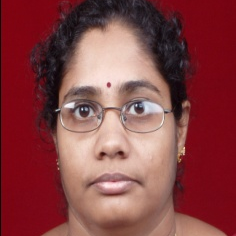
Ramadevi Rathinasabapathy
Work place: Sathyabama Institute of Science and Technology/Electronics and Instrumentation Engineering, Chennai, 600119, India
E-mail: rama_adarsh@rediffmail.com
Website:
Research Interests: Artificial Intelligence, Neural Networks, Computer Architecture and Organization, Image and Sound Processing, Data Structures and Algorithms, Logic Calculi
Biography
Ramadevi Rathinasabapathy born at chidambaram on 5th March 1969. She graduated from Annamalai University in 1992 with Bachelor’s Degree in Electronics and Instrumentation Engineering. She has received her M.E in Electronics and Control Engineering and Ph.D from Sathyabama University, Chennai in 2004 and 2013 respectively. Presently she is working as a Professor in the department of Electronics and Instrumentation Engineering, Sathyabama Institute of Science and Technology, Chennai. She has more than 21 years of teaching experience and 10 years of research experience.
Guided more than 10 master’s dissertation and more than 100 B.E projects in the area of Electronics, Instrumentation, Microprocessor, Microcontroller, Digital Signal Processing, Neural Network, Fuzzy Logic, Wavelet Transform etc. Her areas of interests are instrumentation, condition monitoring, signal/image processing and analyzing, applications of artificial neural network, Fuzzy Logic and Wavelet Transform and soft computing. She has published about 20 research publications in various national/international journals and conferences. She has successfully completed 2 R&D sponsor projects in collaboration with IGCAR as a co-investigator in the area of artificial neural network and wavelet Transform Techniques.
She is a life member of Instrument Society of India (ISOI).
Author Articles
Performance Analysis of Convolution Code with Variable Constraint Length in Shallow Underwater Acoustic Communication
By Krishnamoorthy Raghavan Narasu Suriyakala C D Ramadevi Rathinasabapathy Marshiana Devaerakkam Sujatha Kumaran
DOI: https://doi.org/10.5815/ijcnis.2019.02.02, Pub. Date: 8 Feb. 2019
One of the most complex environment for the data transmission is the underwater channel. It suffers frequency selective deep fading with serious multi path time delay. The channel also has limited bandwidth. In this paper, the effect of Least Code Weight – Minimum Hamming Distance (LCW-MHD) polynomial code is studied using Viterbi Decoding Algorithm for the shallow Underwater Acoustic Communication (UAC) channel. Two different channels with the range of 100 and 1000 meters are considered for simulation purpose and the channel is designed using Ray Tracing algorithm. For data and image transmission in the channel, three different code rate of 1/2, 1/3 and 1/4 are considered and corresponding Bit Error Rate (BER) are evaluated. Result showed that the BER is least for the LCG-MHD polynomial code.
[...] Read more.Other Articles
Subscribe to receive issue release notifications and newsletters from MECS Press journals